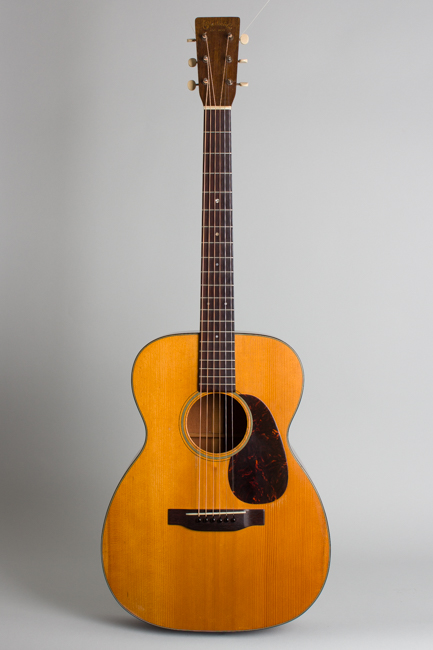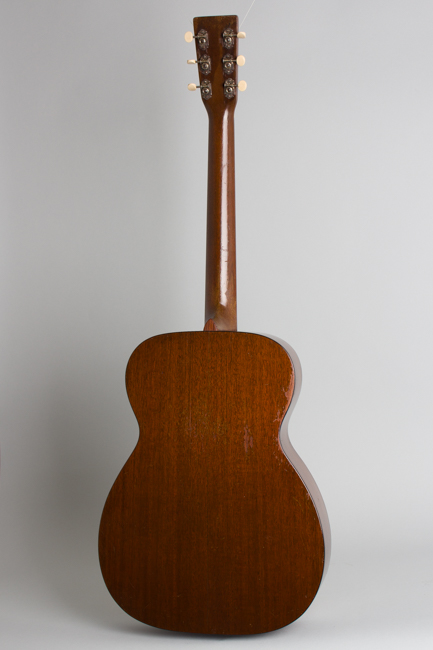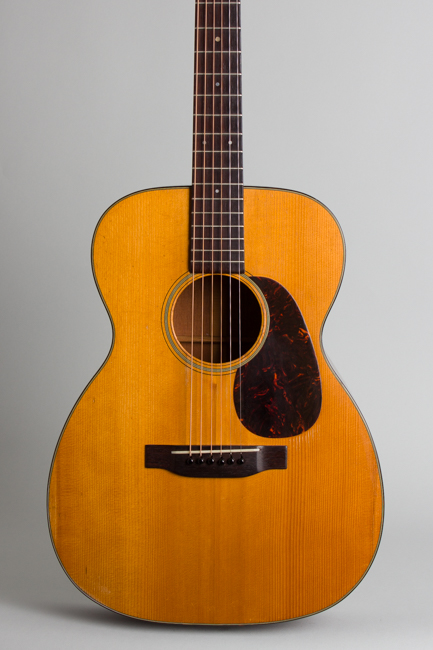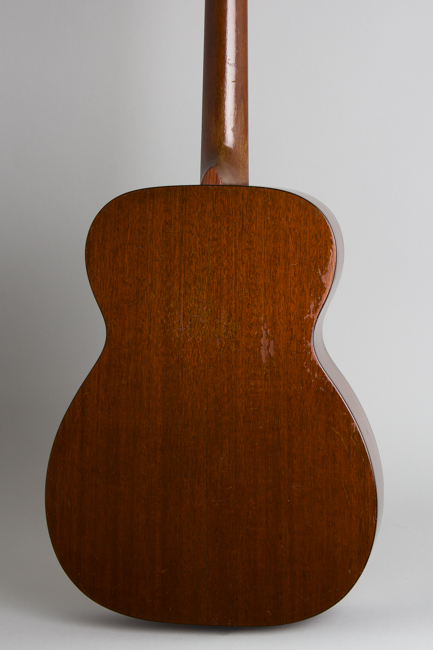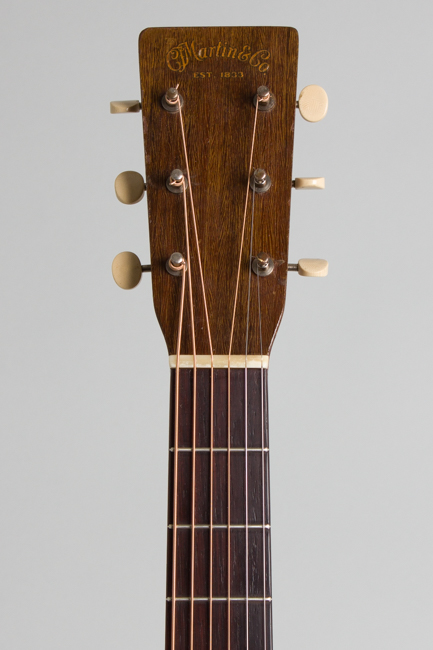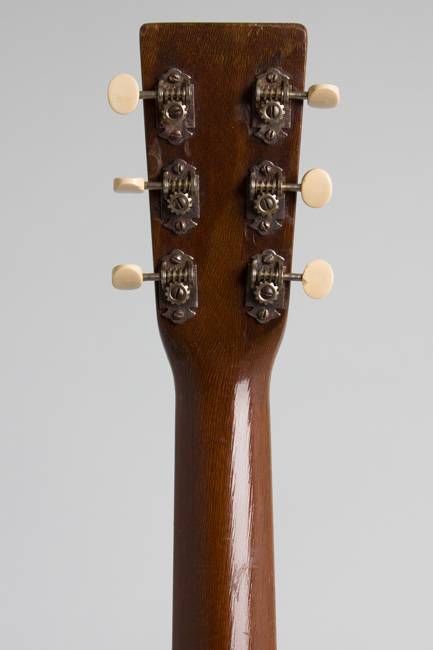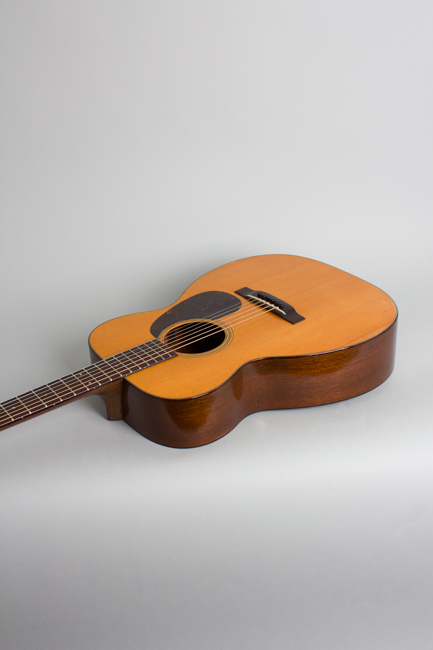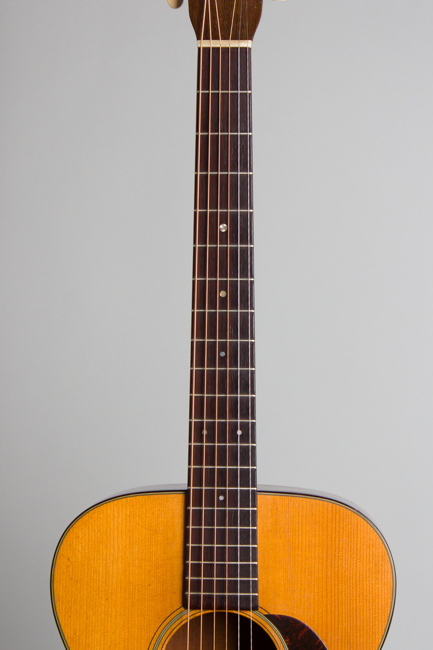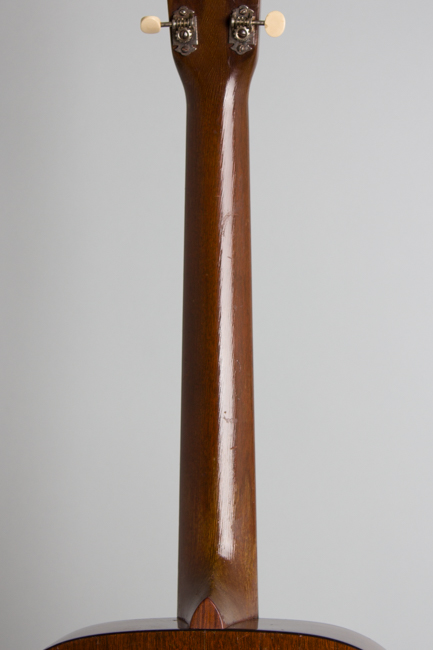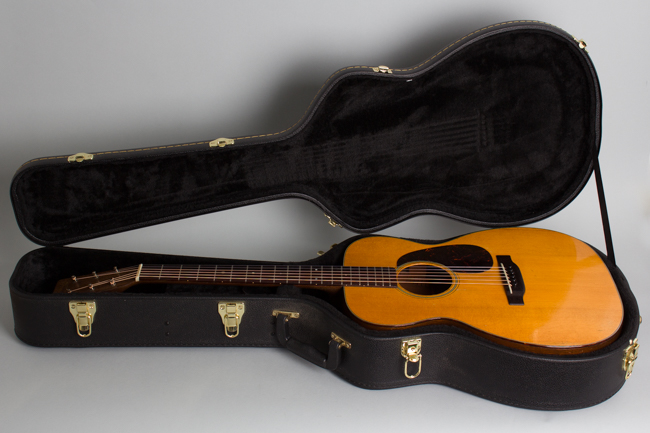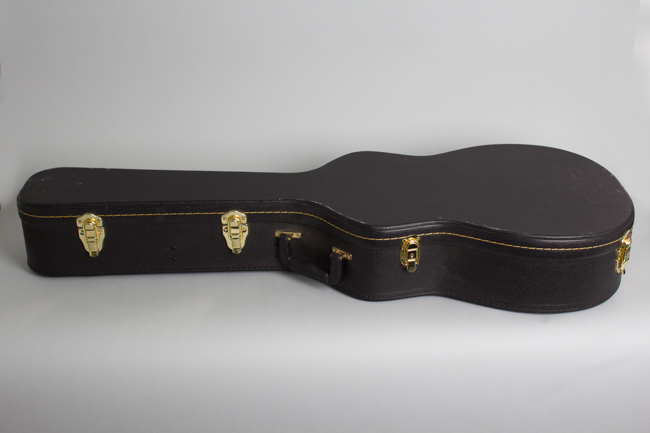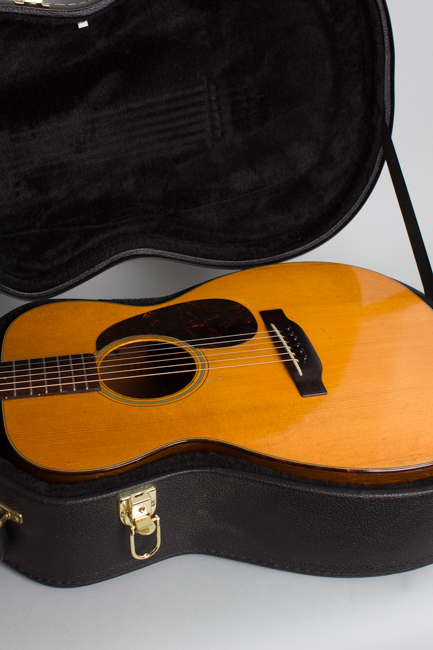C. F. Martin 00-18 with 1944 neck Flat Top Acoustic Guitar (1941)
This item has been sold.
Item # 11952
Prices subject to change without notice.
C. F. Martin 00-18 with 1944 neck Model Flat Top Acoustic Guitar (1941), made in Nazareth, PA, serial # 79303, natural lacquer finish, mahogany body and neck, Adirondack spruce top, rosewood fingerboard and bridge, black tolex hard shell case.
This is a Martin with a very unusual circumstance, having a slightly later (but still period) 1944 neck with an ebony truss rod on a late 1941 body. While this is not uncommon circumstance for say, a bolt-on neck fender guitar, it is quite unusual for a vintage Martin! Apparently one guitar suffered total destruction of the body, another an unredeemable neck situation and voila, a match was made resulting in this featherweight and great sounding tone machine!
In general the 00-18 is not one of Martin's rarer or more hallowed creations, but to many players this model constitutes one of the company's most propitious combinations of wood, wire and inspiration. This late 1941 mahogany body has a delicately scallop-braced Adirondack spruce top making for very light and superbly responsive instrument. The nicely ambered spruce shows a wider grain than some from this period; interestingly enough it appears to be made up from four pieces, with small fillets at each far edge of the lower bout.
This 00-18 was originally built near the end of 1941, just before the nation plunged into WWII. It is one of 251 shipped that last year before Wartime restrictions kicked in, listing at $55.00 (plus case; just raised from $50). The bridge and fingerboard are rosewood, recently changed from ebony. The neck on this guitar is generally similar to what it would have originally been in 1941 with one important change; the metal reinforcing rod was replaced with ebony, the result of metal rationing. This results in a super light 14-fret Martins. The profile is slim and rounded with just the hint of a "V"; the tuners are 1940 style Waverly machines that likely came from the original 1941 neck.
The 00-18 is not a flashy guitar; the trim is discreet with tortoise celluloid binding on the outer body edges, a tortoise celluloid pickguard and a simple multiply celluloid soundhole ring. In classic Martin style, the elegant understatement speaks for itself. Despite its smaller size body and lack of flash this was a fully professional-quality instrument described as fully suitable "for broadcasting or stage work".
In the years since, Martins of this era have become the benchmark for subsequent acoustic guitar designs. The 00-18 is on the small side compared to the more ubiquitous dreadnoughts, making for a very easily handling guitar. Despite this it offers a surprisingly powerful sound and is an extremely versatile instrument, a delightful fingerpicker with a strong reserve of sound if driven with a flatpick. The scalloped bracing makes a major sonic difference on smaller bodied guitars, and this instrument has a wealth of tone not evident on most 00's from the post-war period An ideal writing or recording instrument as well as stage guitar, this carefully combined "Frankenstein" 00 remains a wonderful creative tool and a beautifully resurrected survivor of Martin's "Golden Age".
Overall length is 39 3/8 in. (100 cm.), 14 3/8 in. (36.5 cm.) wide at lower bout, and 4 1/8 in. (10.5 cm.) in depth at side, taken at the end block. Scale length is 24 3/4 in. (629 mm.). Width of nut is 1 5/8 in. (41 mm.).
For having quite a unique history this 00-18 has components to make this a very lightweight and resonant mid-sized Martin, with many more years of play in store. The "new" 1944 neck was very neatly and properly set at the time of installation, and there is a small chip in the heel that was previously filled in with mahogany and capped with a piece of rosewood. The fingerboard has been neatly planed and refretted with fret wire that is comparable to the period and a new bone nut. The neck has checking in the finish over the entire surface that is noticeable to the touch, with some small dings and dents.
On the body the original lacquer finish is decently preserved, with dings, dents and scrapes to the top and some strum wear along the pickguard edge and soundhole, with one area on the lip lightly finished over. The back and sides have a fair amount of scratches, dings, and nicks mostly centered on the back around the waist and upper bout from belt buckle wear.
The guitar has only a two visible cracks that are well sealed. One is located at the center of the back on the treble side, the other on the top along the bass side of the lower bout. Internally, all of the original braces and bridgeplate have remained intact. The bridgeplate has had the bridge pin holes recently plugged and redrilled to prevent further deterioration. The original rosewood bridge has been lowered on the top, and has a new bone saddle installed. The headstock has a pre-war set of Waverly tuners that are fully functional. The guitar is housed in a modern hardshell case. Overall Excellent - Condition.
This is a Martin with a very unusual circumstance, having a slightly later (but still period) 1944 neck with an ebony truss rod on a late 1941 body. While this is not uncommon circumstance for say, a bolt-on neck fender guitar, it is quite unusual for a vintage Martin! Apparently one guitar suffered total destruction of the body, another an unredeemable neck situation and voila, a match was made resulting in this featherweight and great sounding tone machine!
In general the 00-18 is not one of Martin's rarer or more hallowed creations, but to many players this model constitutes one of the company's most propitious combinations of wood, wire and inspiration. This late 1941 mahogany body has a delicately scallop-braced Adirondack spruce top making for very light and superbly responsive instrument. The nicely ambered spruce shows a wider grain than some from this period; interestingly enough it appears to be made up from four pieces, with small fillets at each far edge of the lower bout.
This 00-18 was originally built near the end of 1941, just before the nation plunged into WWII. It is one of 251 shipped that last year before Wartime restrictions kicked in, listing at $55.00 (plus case; just raised from $50). The bridge and fingerboard are rosewood, recently changed from ebony. The neck on this guitar is generally similar to what it would have originally been in 1941 with one important change; the metal reinforcing rod was replaced with ebony, the result of metal rationing. This results in a super light 14-fret Martins. The profile is slim and rounded with just the hint of a "V"; the tuners are 1940 style Waverly machines that likely came from the original 1941 neck.
The 00-18 is not a flashy guitar; the trim is discreet with tortoise celluloid binding on the outer body edges, a tortoise celluloid pickguard and a simple multiply celluloid soundhole ring. In classic Martin style, the elegant understatement speaks for itself. Despite its smaller size body and lack of flash this was a fully professional-quality instrument described as fully suitable "for broadcasting or stage work".
In the years since, Martins of this era have become the benchmark for subsequent acoustic guitar designs. The 00-18 is on the small side compared to the more ubiquitous dreadnoughts, making for a very easily handling guitar. Despite this it offers a surprisingly powerful sound and is an extremely versatile instrument, a delightful fingerpicker with a strong reserve of sound if driven with a flatpick. The scalloped bracing makes a major sonic difference on smaller bodied guitars, and this instrument has a wealth of tone not evident on most 00's from the post-war period An ideal writing or recording instrument as well as stage guitar, this carefully combined "Frankenstein" 00 remains a wonderful creative tool and a beautifully resurrected survivor of Martin's "Golden Age".
Overall length is 39 3/8 in. (100 cm.), 14 3/8 in. (36.5 cm.) wide at lower bout, and 4 1/8 in. (10.5 cm.) in depth at side, taken at the end block. Scale length is 24 3/4 in. (629 mm.). Width of nut is 1 5/8 in. (41 mm.).
For having quite a unique history this 00-18 has components to make this a very lightweight and resonant mid-sized Martin, with many more years of play in store. The "new" 1944 neck was very neatly and properly set at the time of installation, and there is a small chip in the heel that was previously filled in with mahogany and capped with a piece of rosewood. The fingerboard has been neatly planed and refretted with fret wire that is comparable to the period and a new bone nut. The neck has checking in the finish over the entire surface that is noticeable to the touch, with some small dings and dents.
On the body the original lacquer finish is decently preserved, with dings, dents and scrapes to the top and some strum wear along the pickguard edge and soundhole, with one area on the lip lightly finished over. The back and sides have a fair amount of scratches, dings, and nicks mostly centered on the back around the waist and upper bout from belt buckle wear.
The guitar has only a two visible cracks that are well sealed. One is located at the center of the back on the treble side, the other on the top along the bass side of the lower bout. Internally, all of the original braces and bridgeplate have remained intact. The bridgeplate has had the bridge pin holes recently plugged and redrilled to prevent further deterioration. The original rosewood bridge has been lowered on the top, and has a new bone saddle installed. The headstock has a pre-war set of Waverly tuners that are fully functional. The guitar is housed in a modern hardshell case. Overall Excellent - Condition.
